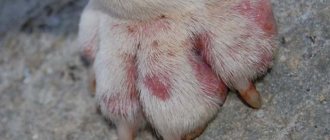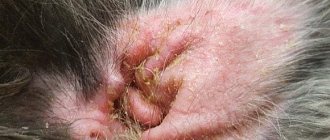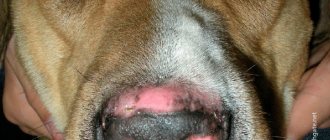The temperature and humidity of a dog's nose change depending on the well-being of its owner. Most often, these indicators are influenced by non-hazardous factors: weather, fatigue or sleep. Until you find out the exact reason, you should not panic. Immediate help is required only when the dog's nose festers. Such discharge always indicates pathology, and delayed treatment can result in serious complications.
Main causes of pathology
Infection can be not only primary, but also secondary. Each of these types requires different treatment methods, so at the first sign of discomfort, your pet should be booked for diagnostics at the nearest veterinary clinic.
Allergy
Allergic reactions greatly weaken the immune system, so secondary infection is not uncommon. The most common allergens include food, pollen, tobacco smoke and household chemicals.
Polyps and neoplasms
Unlike allergens, polyps are permanently located in the sinuses. Because of this, the symptoms they provoke do not subside and only get worse. The risk of malignant degeneration of polyps is very low. Most often, older animals suffer from cancerous tumors.
Infectious diseases
The causative agents of infectious diseases are bacteria, viruses and fungi. Because of them, ordinary rhinitis develops into a purulent form. Particularly dangerous pathologies include plague and adenovirosis, which give complications to the lungs, heart and stomach.
Nose and head injuries
Another possible cause is mechanical injuries affecting the nasal septum. A dog can get hurt not only in a fight, but also in an unsuccessful jump, running into a wall while catching a ball. In this case, breathing problems that provoke inflammation occur due to the displacement of the natural position of bones and cartilage.
If the injury occurred right before your eyes, lay the victim on his stomach, placing his head on his front paws. Apply a cold compress to the area of the injury and contact your veterinarian.
Dental problems
Dental problems are caused by injuries, low immunity and improperly selected food (too soft or too hard). As a result of gingivitis, tooth root abscess or oronasal fistula, infection from the oral cavity enters directly into the nasal passages, aggravating the existing inflammation.
Contact with irritants and foreign bodies
Irritation of the mucous membrane may be due to inhalation of toxic fumes or a foreign object stuck inside the nose. In the latter case, the animal may start bleeding from the nose, but do not try to remove the object yourself. If you make a mistake in your calculations, you can push it even deeper and completely block the access of oxygen.
Congenital pathologies of the nose structure
The purulent form of rhinitis is often found in brachycephalic breeds (pugs, bulldogs, Pekingese). Due to the shortened nasal passages, the breathing of these dogs is difficult from birth, so they must be kept in the most comfortable conditions.
Aviary cough
Enclosure cough is caused by Bordetella bacteria and parainfluenza viruses. The risk group includes residents of shelters kept in crowded conditions. In addition to purulent exudate, patients experience frequent and prolonged coughing attacks.
Causes
This phenomenon is caused by both harmless factors, such as hunger, and serious diseases. The main reasons include the following:
Hunger. In this case, foamy saliva appears in the corners of the mouth, and a long break between feedings may result in single vomiting.- Mechanical irritation. If the dog chewed on a stick or bone, the pieces could get stuck between the teeth and injure the oral cavity. If a dog chews food poorly and swallows it in chunks, this causes irritation of the digestive organs. Gastric juice and mucus combine with air, causing foaming.
- Medicines. Bitter drugs entering the oral cavity cause a slight foamy discharge, and medications in tablet form can irritate the larynx.
- Poisoning. During a walk, the dog may swallow an insect or even a frog. The latter produce burning mucus that irritates the stomach. A pet can also be poisoned by poor-quality food or poison.
- Anesthesia. The end of its action is often accompanied by vomiting, foamy discharge from the mouth, and muscle tremors.
- Riding in transport. Many animals get motion sickness while traveling in a car, which stimulates salivation and foam production.
- Pain syndrome. The pain can provoke the urge to vomit and foaming of saliva. The same symptoms are often observed after overheating of the body or as a consequence of injury.
- Virus infection. They cause diseases such as enteritis, carnivore plague, and rabies.
- Gastrointestinal diseases. Disturbances in the functioning of the liver and gallbladder lead to foaming and frequent vomiting.
- Cardiovascular pathologies. A state of hypoxia and a heart attack cause blue mucous membranes, difficulty breathing, foaming from the mouth, and rapid heartbeat. Epileptic seizures occur with profuse flow of foam and convulsions throughout the body.
- Diseases of the oral cavity. Pathologies of teeth and gums caused by bacteria often cause saliva to foam and flow from the mouth. New growths in the mouth and throat are also accompanied by this symptom.
Associated symptoms that may help in diagnosis
Purulent nasal discharge in dogs can be green, yellow, cloudy white, or dirty gray. The color depends on the cause and severity of the inflammatory process. Also, as the disease progresses, a change in smell and consistency occurs. The discharge becomes foul-smelling and thickens.
A presumptive diagnosis can be made based on accompanying symptoms:
- sneezing, increased tearing, skin rashes - allergies;
- unilateral nosebleeds, muzzle deformation - polyps and neoplasms;
- changes in behavior, lack of appetite, fever, vomiting and diarrhea - infections;
- severe pain, swelling, sleep disturbances - injuries;
- swelling of the gums, unpleasant odor from the mouth, change in the shade of the enamel, refusal of food and water while maintaining appetite and thirst - dental problems;
- vomiting, diarrhea, breathing problems, nosebleeds - inhalation of toxic fumes or foreign objects;
- inflammation of the lymph nodes, paroxysmal cough - kennel cough.
Common symptoms include itching, which occurs due to the accumulation of dried pus. The resulting crusts irritate the sinuses, forcing the pet to scratch with its own paws or against surrounding objects.
A dog's runny nose may be a symptom of a serious illness.
Don't let the disease take its course. It is also possible that rhinitis is just the tip of the iceberg. For example, a runny nose is one of the symptoms of plague, inflammation of the pharynx, adenovirus, and tuberculosis. Of course, we really want these terrible diseases to pass by our pets, but it is better to know about their symptoms and take action in time. Plague can be asymptomatic, and it is the dog’s runny nose that will help the veterinarian make an accurate diagnosis and begin treatment on time. It’s so easy to take some nasal discharge on a cotton swab and send it for analysis.
If your pet suffers from a runny nose, then please have pity on other animals and do not go to the veterinary clinic, where he can easily infect others. It’s better to call a veterinarian at home. It may be more expensive, but you wouldn't want your dog to get infected at the vet either. For example, the disease adenovirosis (infectious laryngotracheitis) is very contagious. Caring for the health of dogs lies solely with their owners. If your dog suffers from a runny nose, do not think that everything will go away on its own. Be sure to treat your pet. I wish the owners and their dogs good health.
A dog is man's best friend. And we love our friends and try to protect them from all sorts of diseases. But no less a friend can be identified by his nose. When healthy, the nose should be wet and cold; in some breeds it should be warm and dry. But sometimes we may encounter such a problem as a hot crusty nose and small cracks or snot in our pet. If your dog is sneezing, scratching his nose, snorting, or breathing heavily, you should consider visiting the veterinarian.
The answer to the question of why my pet’s snot is not as easy to find as I would like. After all, there are many reasons why dogs have a runny nose. Among them there are common colds and serous viral diseases, and so the reasons:
- Colds, rhinitis
- Allergy
- Harmful fumes
- Foreign object
A runny nose can also be a symptom of such deadly diseases as plague, adenovirus, calcivirosis, so we strongly RECOMMEND that you consult a veterinarian!!!
1. 2. 3. 4. 5. 6.
First of all, you need to determine the cause of the runny nose and only then look for treatment methods:
If your dog has snot as a result of a mild cold, you shouldn’t worry too much, because it has virtually no effect on the pet’s general condition. He still remains cheerful and eats well.
Infection. The virus that has entered the dog’s body will manifest itself very quickly and “vividly”. You will be able to see a rise in temperature, enlarged lymph nodes and a general loss of strength. Another very important symptom is mucous discharge from the nose, which the dog constantly licks off.
Foreign object. If smoke, dust, a small pebble or something else gets into your pet's nose, the nasal mucosa is irritated, and this causes snot to appear. It is worth noting that if a foreign object gets into the dog’s nose, it will also be active and have a good appetite.
Rhinitis. This is the medical term for a dog with a runny nose. The reasons are very different: hypothermia, sudden changes in external temperature, too hot or very cold air, inhalation of smoke or other substances.
Symptoms will include discharge of a transparent color and liquid composition; after a while they become thicker, and then dry out and form hard crusts on the nose.
Tests and research in the veterinary clinic
All detected symptoms must be listed to the doctor. This is necessary to collect anamnesis and determine research. Depending on the situation, making a diagnosis may require:
- urine and blood tests that help detect the cause of the disease based on deviations in basic indicators;
- Ultrasound, X-ray and MRI, which determine the presence of tumors, foreign bodies and injuries;
- cytology of swabs from the nose and mouth, identifying the causative agent of infection;
- rhinoscopy, assessing the condition of the sinuses and nasopharynx.
After receiving all the results, an individual treatment plan is selected for the four-legged patient. Until this point, it is better to avoid taking medications, heating and other manipulations with a sore nose. Without knowing the cause, you will only worsen the dog's condition and slow down its recovery.
Prescription of treatment according to the identified disease
The main goal of treatment is to eliminate the underlying disease. For this purpose, medicinal and surgical methods are used. In the first case, they limit themselves to taking medications, and in the second, they resort to surgical intervention.
Surgery under general anesthesia is indicated for the presence of tumors and injuries to the nasal septum. Anesthesia is also used when treating teeth and removing a deeply embedded foreign object. In all other cases, for recovery it is enough to take a course of medications, combining their use with physiotherapy and skincare procedures.
Taking medications: tablets, drops, ointments
Depending on the pathogen found, the four-legged patient is prescribed antibiotics, antiviral or antifungal tablets and drops. The dosage and duration of drug therapy is determined individually, so simply follow the recommendations of your doctor.
Additional drugs include:
- antihistamines and glucocorticosteroids that suppress allergic reactions;
- immunomodulators that restore the body's defenses;
- analgesics, anti-inflammatory and hemostatic, helping to cope with the symptoms that arise;
- infusion solutions that stimulate the removal of harmful toxins.
It is also mandatory to prescribe ointments for treating the sinuses. They neutralize the pathogen, relieve inflammation and accelerate the regeneration of damaged tissues.
Warming, rinsing, inhalation
The outflow of purulent exudate is stimulated by the Sollux infrared lamp. When exposed to heat, blood vessels dilate, restoring blood circulation. Compresses with heated salt create a similar effect. Please note that this procedure is contraindicated in case of high fever and bleeding. Before carrying out this procedure, it is necessary to obtain appropriate permission from a veterinarian.
Drying crusts of pus are soaked with chlorhexidine, miramistin or other antiseptics without alcohol. Herbal infusions of sage or calendula also cope with this task. After removing the crusts, the nasal passages are washed with a syringe, using medications prescribed by the doctor.
For breathing problems, steam inhalation is recommended. A steam-filled bathroom or a special inhaler with a small amount of heated water with essential oils (mint, eucalyptus, tea tree) is suitable for this.
Hygiene and care
During treatment, the patient is isolated in a separate room to avoid infecting other pets. The chosen place is insulated and protected from drafts, and all ventilation is provided during walks or feeding. Please note that the duration of walking will have to be reduced, and physical activity will have to be completely eliminated.
All food served must be easily digestible. It is recommended to warm it to room temperature. Particular attention should be paid to drinking. In addition to plain water, you can include rosehip decoctions in your diet, which strengthen the immune system.
Treatment of dog runny nose
When the first alarming symptoms appear, try to interrupt the dog’s contact with the irritant. Stop smoking in the presence of your pet, check if he has an allergic reaction to perfumes, household chemicals, pollen, or the smell of indoor plants. Start treating a runny nose at home and monitor your dog's well-being. If it gets worse, contact your veterinarian.
What to do at home
First, find out how a runny nose manifests itself. This is sneezing, unilateral or bilateral discharge. When the dog just sneezes and feels fine, try to identify and eliminate the irritant. It is possible that this is perfume, or a bouquet given by a loved one.
Vacuum sofas and carpets more often, carry out wet cleaning, remove newly purchased ornamental plants, and interrupt the dog’s contact with other pets.
Provide your pet with a comfortable microclimate. Do not allow lying on bare concrete or use air conditioners in the presence of the dog. Sometimes these measures allow the dog to overcome a runny nose on its own without the use of medications.
To treat a runny nose at home, use eye and intranasal drops Anandin or Maxidin 0.15. Keep one of the medications in your first aid kit.
If crusts have formed on your nose, remove them by soaking them with water. Administer 2-3 drops 3 times a day until recovery. Rhinitis is often accompanied by conjunctivitis, so apply the product into your eyes to prevent inflammation. If you use Anandin, do not confuse the drug with ear drops of the same name.
If the medicine does not help and your pet's condition worsens, contact your veterinarian.
If you suspect a foreign body has been introduced, try shining a flashlight into your nostrils and pulling out the foreign object with tweezers. If it doesn’t work, contact a specialist.
In what cases should you contact a veterinarian?
The following symptoms and circumstances are grounds for contacting a veterinarian:
Depending on the diagnosis, the following treatment methods are prescribed:
- Conservative therapy. To eliminate the cause of the disease, antibiotics, antivirals, and hemostatics are used. desensitizing agents, nasal drops, cardiac medications. For a speedy recovery, general health-improving medications, hepatoprotectors, breathing aids, probiotics, and veterinary food are prescribed.
- Surgical treatment is required to remove a foreign object from the nose, as well as to remove benign tumors.
The veterinarian will make a diagnosis and prescribe treatment, and you will have to acquire the skills of a nurse and carry out treatment procedures yourself.
Not all antimicrobial agents are suitable for dogs. Some antibiotics have a short duration of action; they have to be injected several times a day. Others are contraindicated for dogs that have not finished growing because they interfere with the formation of bone and cartilage tissue. Still others have a narrow range of antimicrobial action. Sinulox does not have such disadvantages. This is an injection analogue of the drug Amoxiclav. It has no contraindications except for individual intolerance to the ingredients. Injections are given once a day. The course of antibiotic therapy is 3-5 days in a row. The cost of a 40 ml bottle is 920 rubles. Dosage - 1 ml/20 kg of live weight. After piercing the cork, the drug must be used up within 28 days.
What not to do
When caring for a sick dog, the main thing is to do no harm. Therefore, read what you should not do. A dog’s physiology is different from yours, so the answer to the question “is it okay to use human nose drops?” unambiguous: it is impossible without the consent of a veterinarian. Avoid “helpful advice” and do not use folk remedies. At best, they will cause neither harm nor benefit. Do not invent powders from medical antimicrobial agents; their use may cause an allergic response.











